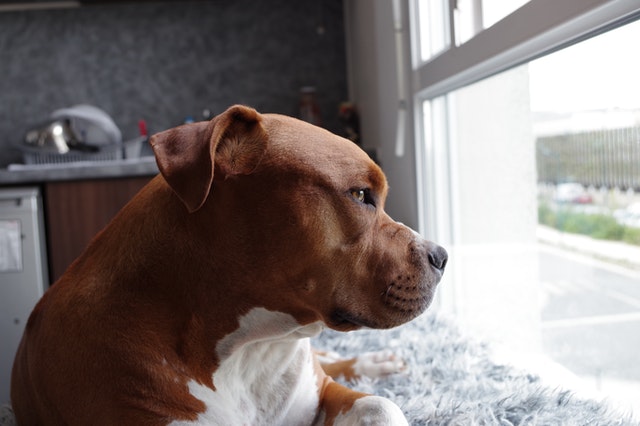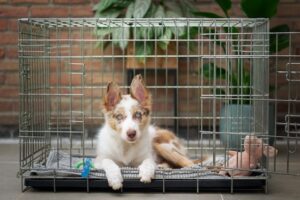So your dog refuses to play with its toys.
This may seem like an odd problem since most puppies are ready to play with everything in sight. But when you give Fido a brand new toy, he just looks at it quizzically, or simply turns away.
What is he thinking? Is your pup alright? Is this behavior normal?
Read on to discover what might be going through your dog’s mind and learn how to encourage him to engage with his toys.
Reasons Why Your Dog May Not Want to Play With His Toys
Dogs are known for their playful and energetic nature. They love to run, jump, and chase things. Playing with toys is one of their favorite activities.
However, some dogs don’t show any interest in toys, which can cause concern for their owners.
If your furry friend is not interested in toys, there can be several reasons behind it.
- It’s not the right toy for him
- He doesn’t know what to do with it
- He is bored
- Lack of exercise
- Health issues
- Age
- Trauma
It’s not the right toy for him
Every puppy has a different personality. They are motivated by different things when it comes to playing.
Your pooch may like being rewarded with treats. Or he may only like things that make a squeaky noise.
If Fido does not show interest in the toys he has, he might like playing differently.
He doesn’t know what to do with it
Do you give your dog a shiny new toy and then leave him alone to play with it all afternoon?
Maybe your puppy needs a little introduction to this new foreign object before he fully understands what to do with it.
He is bored
If Fido doesn’t show interest in his toys even though he loved them last week, he might simply be bored.
This can be due to several reasons. He may be tired of his old favorites and wants something new to play with. Your dog may want to go outside after being at home all day. He could also simply want your attention instead of his old pile of toys.
Lack of exercise
Well, if your furry friend is snubbing his toys, one of the top culprits is a lack of exercise. Yes, your pooch needs to stretch his legs and burn some calories to stay fit and energetic.
If he’s not getting enough activity, he might turn into a couch potato and show zero interest in playtime. And let’s face it, nobody wants a pup who’s more “meh” than “woof!”
Health issues
If your dog’s disinterest in toys is accompanied by a general lack of energy, appetite, or interest in other activities. It could be a sign of a more serious health issue.
For example, dogs with dental problems, arthritis, digestive issues, or other medical conditions may find playing with toys uncomfortable or painful.
If you suspect that your dog’s health is affecting their playfulness, it’s best to consult a veterinarian for a check-up and advice.
Age
Age can also play a role in your dog’s attitude towards toys. Just like us humans, dogs tend to slow down a bit as they get older. So, your pupper may not have the same energy and curiosity they once had. Maybe they’re just more interested in a good nap than a game of fetch.
And let’s not forget about the senior dogs – they may have some physical limitations or health issues that make playing with toys a bit of a hassle. But don’t worry, it doesn’t mean they don’t want your love and attention. They just might prefer some snuggles and scratches instead of chasing after a tennis ball.
Trauma
Finally, trauma or anxiety can be a factor in your dog’s reluctance to play with toys. Dogs that have been mistreated, neglected, or exposed to frightening or overwhelming experiences may associate toys or play with negative emotions or memories.
Similarly, dogs that are prone to anxiety or stress may find it hard to relax and have fun when presented with toys. If you suspect that your dog has trauma or anxiety-related issues, it’s essential to seek professional help from a qualified behaviorist or trainer who can devise a tailored plan for their needs.
How to Get Dogs to Play With Their Toys?
Encouraging your dog to play with toys is easier than you might think. The best part is that it’s completely achievable!
Start with a simple toy
The best way to get your puppy comfortable with toys is to start with something simple.
Get a toy that Fido can naturally interact with. Choose a toy that you can play with together, such as a rope toy or a Kong.
A rope toy is easy to grab and you can quickly make your puppy understand that he has to pull at the other end. Another great option is a Kong that you can stuff with treats. As he tries to get the food out, he will soon start to enjoy himself while doing it.
Reward him with treats or praise even if he interacts with the toy for a very short time.
Get excited
Don’t you love it when your pup mirrors your behavior?
When you walk into the room, he is ecstatic to see you. When you’re feeling lazy and relaxing in the afternoon, he lies down next to you and dozes off.
You can use this adorable habit to get him excited about his toys too.
Every time Fido goes near his toy to sniff it or touch it, make a big deal out of it. Show him that it is exciting and encourage him in a high-pitched voice. You can also wiggle the toy around to make it seem animated so that your puppy gets interested.
Clap and praise him loudly every time he successfully interacts with the toy. If your dog sees that you enjoy playing with toys, he may become more interested in them too.
Use food as motivation
Some dogs just love food. And your puppy is no different.
You can use his favorite edibles as motivation to get him to interact with his toys. Simply take a durable rubber (such as Kong) and fill it with an irresistible treat. You can use frozen gravy, peanut butter, or his favorite dog treats. Let your puppy sniff the toy.
If he does not start to interact with it, show him how to get the treat out with your hands and let him taste it.
Now let him try doing it himself and praise him as he starts to lick or chew on the toy.
You can also make this a ritual during dinnertime so that he gets excited about playing with his food-stuffed toy.
Participate in one-on-one play
If Fido doesn’t show interest in playing with toys by himself, you can use this opportunity to spend some one-on-one time with him. Your puppy will love your attention and this will give the two of you some precious bonding time.
Teach him how to play easy games like tug and fetch. If he does not want to fetch the ball on his own, you can make him run along with you as you go after it yourself. If you do this several times, Fido will soon understand the rules. Even if he doesn’t, you will end up having plenty of fun together.
Rotate the toys
If your dog isn’t showing interest in playing with his toys, this might be because he has too many of them.
He could be bored, overstimulated, or simply doesn’t know what to do with so many of them.
Rotating his toys makes it easy for your pooch to interact with them and also keeps him curious every time you bring out a new one. Give him a small batch of toys every week. As he learns to play with them, keep the other toys out of reach.
Be patient
It is important to understand that your puppy has a unique personality and it is okay if he does not want to play with every toy.
Give him time to slowly get habituated to different kinds of toys.
He might end up liking rope toys the most. Or if Fido is a big eater, he might like nothing but food-puzzle toys. Through trial and error, you will soon find out which toys your dog enjoys playing with the most.
Use Positive Reinforcement
Positive reinforcement is a powerful tool when it comes to dog training. When your dog shows interest in a toy, reward them with praise, treats, or a game of fetch.
Which Toys can Be Interesting for the Dogs?
As a dog owner, you want to ensure your furry friend is happy and entertained. One of the best ways to do this is by providing them with toys they enjoy playing with. But with so many dog toys available, how do you know which ones will appeal to your dog?
Check out these paw-some toys that will have your pup wagging their tail with excitement!
a) Chew Toys
Chew toys are a popular choice for dogs of all ages. They come in many shapes and sizes, from simple rubber balls to complex puzzle toys. Chew toys are great for promoting dental health.
There are many types of chew toys that dogs enjoy. Some of the most popular options are KONG Classic, Nylabone Dura Chew, Benebone Wishbone, Himalayan Yak Cheese Chew and Rawhide Bones
b) Interactive Toys
These toys require your dog to solve a puzzle or perform a task to receive a treat or reward and keep your dog mentally stimulated and engaged.
These toys can come in many different forms, such as puzzle feeders, treat-dispensing toys, and interactive games.
c) Plush Toys
Plush toys, such as stuffed animals, can provide comfort and companionship for dogs. They are especially popular with puppies and dogs who enjoy snuggling up to something soft. These toys come in a variety of shapes and sizes, including stuffed animals, balls, and even blankets.
d) Squeaky Toys
Squeaky toys can provide a fun and engaging experience for dogs. The sound of the toy can be exciting and stimulating for dogs who love to play.
Squeaky toys come in various shapes and sizes, from balls to stuffed animals, and are made from different materials such as rubber or plush.
However, it’s important to note that not all dogs enjoy playing with squeaky toys, and some may become obsessive or aggressive
In a nutshell:
As a dog owner, you may find it odd when your pooch doesn’t show interest in playing with his toys. But you shouldn’t be worried just yet. Your puppy might be bored, overwhelmed, or simply does not understand the shiny new toy.
To get him to play with his toys, try to understand what kind of playing he likes, and try to get him interested in his toys by using treats or getting him excited.
You can also use this opportunity to indulge in some one-on-one playtime. By being patient, you will soon be able to find what your dog likes and you’ll be a parent to a busy and happy puppy.









